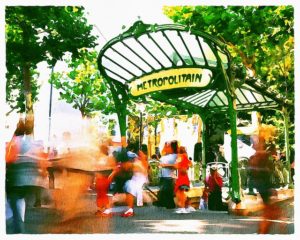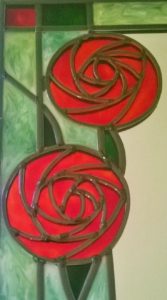Hello Dear Reader and welcome to this post. Today I will be exploring the glorious age of Art Nouveau.
This was a movement from the late 19th through the early 20th century. It was relatively short lived but did bring about many changes to the world of design as we see it today.
Predominantly, it was the embracing of the industrial influences that had taken over architectural design, coupled with a desire to move away from the historical style. It was a move towards reason, clarity, and structure but with a more organic fusion between structure and ornament. Designed to complement the modernist movement.
Much of decorative art to this point had been poor imitations of earlier periods. The founders of Art Nouveau sought to improve the quality of workmanship, raising the status of their craft. This shift in status, would happen but not until the 1920s, when the skill and ability of decorative artists otherwise known as applied art, such as jewellers, textile designers, furniture and interior design were finally recognised as being equal to that of fine art, sculpture, and painting.
They were given the name Art Decorative during the 1925 Paris exhibition of modern decorative and industrial arts. Which then became known to the world as Art Deco. This recognition of skill opened the door for applied artists to flourish and continue to make the world around us a more functionally beautiful place.

Using stylized images of flowers, vines, tendrils, insect wings and rounded forms, the fundamental characteristics of this movement were the ornamental, undulating, asymmetry of line in nature.
I am particularly fond of this movement as I really love the simple satisfaction of a beautiful ink drawing. Although I do feel that I am doing a disservice with the word simple. Appearances are deceptive and “simple” line drawings are in fact very complex.
Art Nouveau has a purity of design. It has an affinity with the pre-Raphaelite, the arts and crafts movement and symbolist style. However, unlike arts and crafts or the symbolists, Art Nouveau has distinguished its design with the fearless use of new materials, machined surfaces, and abstraction.
The designs featured in the period were heavily influenced by Japanese art, namely Karakusa, meaning foreign plant or wilding plant. It is a form abstracted form nature. This Japanese design motif can be clearly seen throughout Art Nouveau.
During this period, the graphic arts flourished with the invention of colour lithography, art was no longer the prisoner of galleries and museums available only to the rich and powerful. It was now found in mass produced posters and magazine illustrations. Its most popular theme was women, they were depicted as glamorous, modern, beautiful, and often surrounded by flowers. There are many examples of Art Nouveau in the advertising of this time for everything from cigarettes to soap.



Architectural design utilized all manner of materials to implement the style into their builds. Using metals, glass, concrete, and ceramics to achieve their vision.
With the general feeling that decorative design could be described as frivolous and overly ornamental, the Art Nouveau movement wanted the function of an object to inspire its form. This was a lofty ideal and not always practical leading to some rather flexible thinking. However, the lasting impact of Art Nouveau was its influences in future modernist styles. Notably Art Deco and Bauhaus.
There were several key artists and architects of this time Hector Guimard, Victor Horta and Charles Renee Mackintosh.
Hector Guimard 1867-1942
Was a French architect and designer, early in his career he achieved fame the Castel Beranger, the first Art Nouveau apartment building in Paris, winning him an award for best new building façade in 1899. He designed the entrance ways or Edicules for the Paris metro using wrought iron and glass. He really was the man of the time with examples of his work appearing everywhere from typeface, fabrics, glass, ceramics, and iron works.
Guimard was heavily influenced by the Belgian architect Victor Horta, especially the Hotel Tassel which he visited prior to designing Castel Beranger. Similar to the ethos of Horta, Guimard created original designs inspired by his view of nature. He was a master at marketing himself and his works, christening it “Style Guimard” and likened it to the flowing sap of a tree, in reference to the liquid abstract quality of his work. The forms and details never really indicative of any particular plant or tree, more of an interpretation of movement rather than a direct copy.



Victor Horta 1861-1947
Was a Belgian architect and is considered to be the father of the Art Nouveau movement with his work inspiring many of his peers and those that followed. The Hotel Tassel in Brussels is often thought of as the first Art Nouveau house, it has subsequently been honoured with World Heritage status listed by UNESCO.
Along with the now familiar vegetal flowing vine and flower motifs which encompasses the style of Art Nouveau, Horta brought about change to architectural design.
His wish was to make living and workspaces light and airy was the beginnings of the open plan styles we are so fond of today. Horta designed buildings to flow and be full of light, achieving this with the removal of walls, opening of staircases and the introduction of skylights.
Wrought Iron was used in abundance to achieve openness, with each support, buttress, and balustrade cast with the ubiquitous vine and flower motifs.
Later in his career his work became less decorative replacing the Art Nouveau motif with a more classical approach, though he never left behind the open plan model of architecture and his attention to detail and craftsmanship never faltered.



Charles Rennie Mackintosh 1868 – 1928
Was a Scottish man born and raise in the fine city of Glasgow. An architect, designer, water colourist and artist. He was one of the most influential and important figures in the British modern style of design.
Although his work is now well regarded, it was not initially well received in his hometown. It was his long-time teacher and friend Francis Newbury who sent his works to fellow artists in Belgium. This act of kindness from a friend, launched Mackintosh onto the European stage.
The Belgians loved his designs and praised his innovative style this was the beginning of his successes in Europe. He was invited to the 8th Sessionest exhibition in Vienna (1900) and then to the exhibition of international Decorative Arts in Turin (1902).
These two events were pivotal to his success at home. He was commissioned to design four tea rooms by the business woman Catherine Cranston, the most famous of these being the Willow Tea Rooms. For this particular tea room Mackintosh was given complete artistic freedom. He used different colour palettes for male and female saloons and designed a deluxe tea room which is adorned with a gesso panel created by his wife Margaret McDonald.



Now in the early 21th century, the forward thinking minimalist aesthetic of Charles Rennie Mackintosh is widely appreciated. It is not the Machine for living aesthetic favored by other modernist architects but more of a homely feel that draws its ideas from the design ideals of Japan.